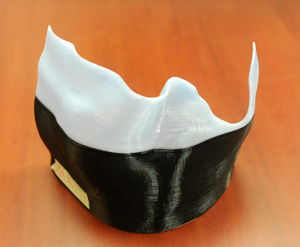James Robar stands in his office at the Victoria General Hospital in Halifax showing off what looks like a piece of abstract sculpture art. The wavy, fragmented object actually holds a far more practical purpose, though: delivering an optimal dosage of radiation to a breast-cancer patient during a treatment.
 The magazine-sized black-and-white item is a physical reproduction of a small portion of a cancer patient’s torso. It was manufactured with a 3D printer located in a room down the hall from Dr. Robar’s office using data gleaned from a body scan and materials that replicate the radiological properties of tissue.
The magazine-sized black-and-white item is a physical reproduction of a small portion of a cancer patient’s torso. It was manufactured with a 3D printer located in a room down the hall from Dr. Robar’s office using data gleaned from a body scan and materials that replicate the radiological properties of tissue.
It’s also a prototype that showcases a unique piece of software Dr. Robar, a faculty member in the Department of Radiation Oncology, and his team of researchers have patented and are now working to get into clinics around the world.
Once on the market, physicians will be able to use the technology to create these one-of-a-kind wearable devices — referred to in the field as "bolus" or "boli" — efficiently and more accurately than in the past.
Exploring Medical Physics
It’s just one example of the kind of cutting-edge, applied technology that helped Dr. Robar secure accreditation earlier this year from the Commission on Accreditation of Medical Physics Educational Programs (CAMPEP) for the Medical Physics graduate program he oversees at Dalhousie.
While Dal has offered courses in the field since 2005, recent changes to requirements for board certification of medical physicists spurred the push for accreditation. These changes mean it will soon be mandatory for students to have graduated from a CAMPEP-accredited institution to get into the right residency programs they need to move on to take the board exam and get certified.
Starting this fall, Dal’s Department of Physics and Atmospheric Science will offer three separate CAMPEP-approved degree programs in Medical Physics: a two-year MSc, a four-year PhD, and a one-year certificate program for students with a PhD in Physics. Students enrolled in either of the first two programs complete eight graduate-level courses in their first year and spend the remaining years working on applied research. The certificate program is built around a year of coursework.
“Dal’s program stood out as one that is particularly excellent in terms of the very practical ideas we develop that will improve the state of the art in radiation oncology physics,” says Dr. Robar, referencing the feedback he received from the accreditors.
Accreditation gives Dr. Robar and the 12 other medical physicists based out of the hospital reassurance that they’ll continue to attract the best and brightest talent to the program.
Immersed in the field
Talent like Lee MacDonald, a graduate of the MSc program and now a PhD student, who does work on a radiation therapy technique that aims to let oncologists spare collateral damage around tumours when treating complex cancers.
“You really feel immersed in the field as opposed to just a classroom setting where these things are just talked about,” says MacDonald, who also finds time to play in a local Halifax rock band called Scrapes when not absorbed in research on campus.

MacDonald says accreditation was on his mind when he looked into medical physics programs a few years ago.
A short two years later and MacDonald is now working with Dal’s Industry Liaison and Innovation office to get his technology licensed.
“To be able to see that kind of a timeline is really motivating. To know that there’s that possibility for something that you’re developing to actually be used in the clinic and to have a real purpose on a short timeline,” says MacDonald.
Applying knowledge
Dr. Robar says part of that boils down to the applied nature of the research. While it often takes 30 years to get a new drug to market, it typically only takes between one and five years for a new product in his field to be approved.
But Dal’s “absolutely leading-edge” facilities, research grants and excellent industry collaborations ensure students get very involved in the developmental side of things, he says.
Reliable financial support for the Medical Physics program from the Nova Scotia Health Authority — in the form of a full funding stipend for seven students — also helped convince accreditors to back the program, says Dr. Robar.
Graduate students with funding work in quality assurance roles at the hospital in the evenings, helping ensure the equipment is working and assisting with patient treatment plans under the direction of a qualified medical physicist.
“While it’s indirect, you’re still a part of this care path,” says MacDonald. “For a new graduate student leaving undergrad, it almost feels like you are engaged in the field already.”
Find out more about Dalhousie’s new Medical Physics programs.

